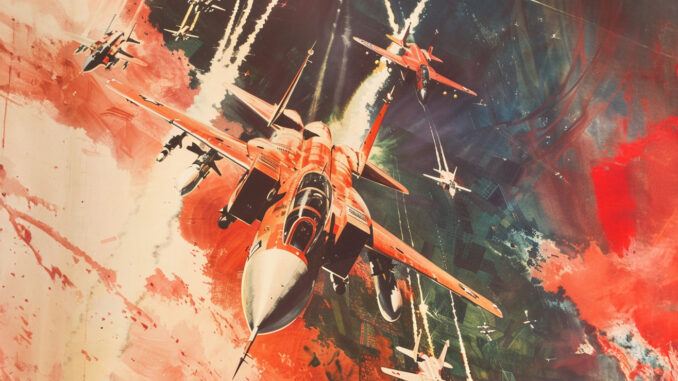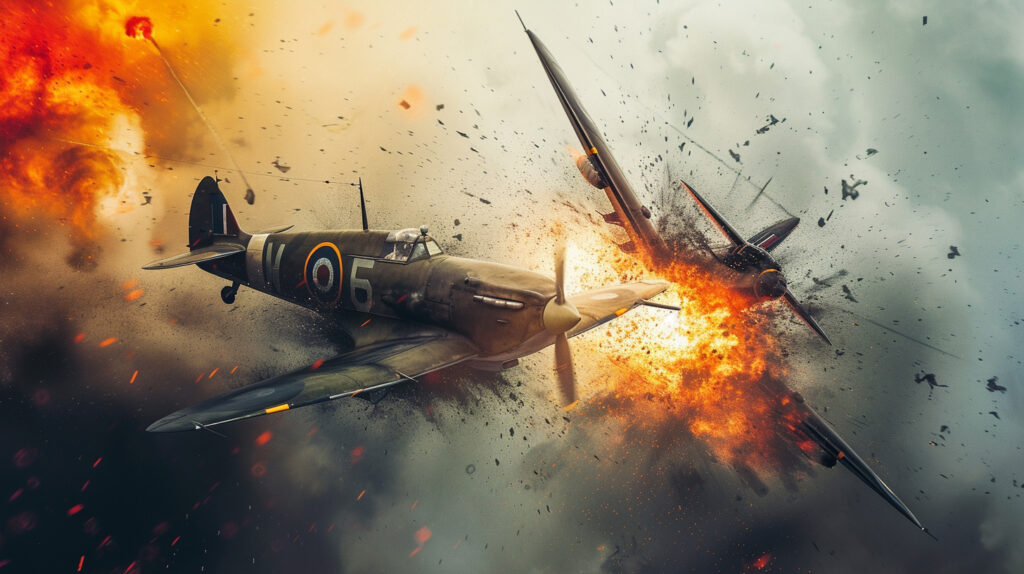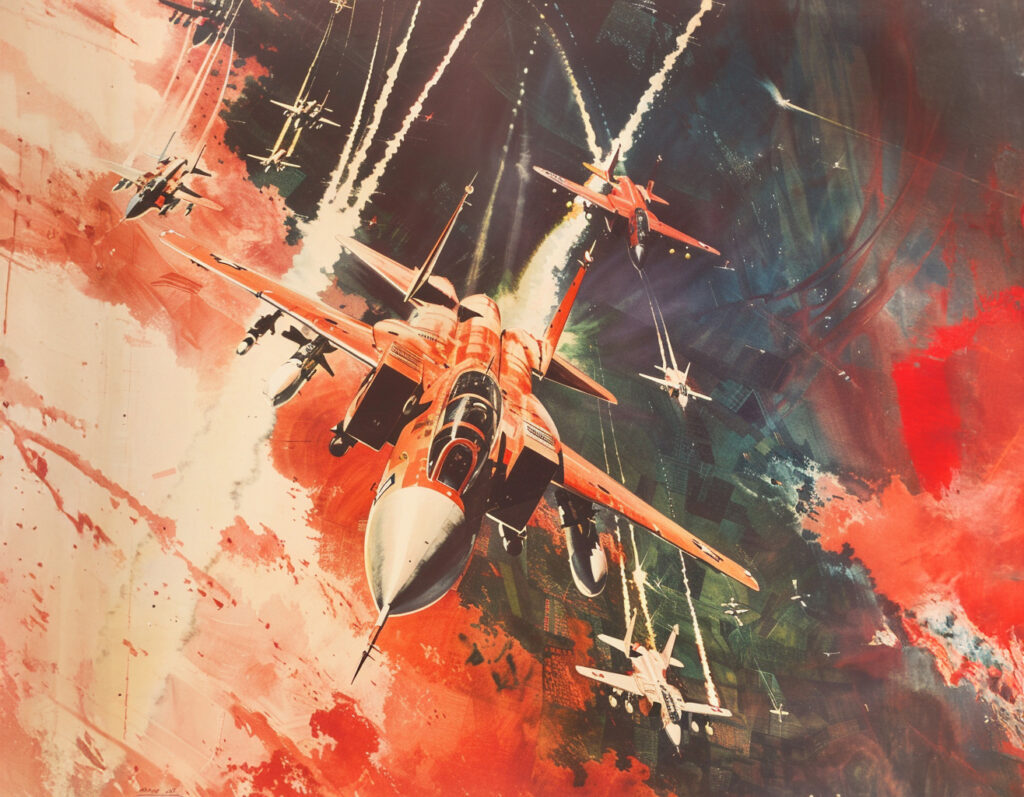
Discover air-to-air and air-to-ground/sea air combat manoeuvres, their techniques and strategic applications for military pilots.
Air combat, also known as dogfighting, has been an essential military technique since the First World War. It involves confrontations between military aircraft in flight. These confrontations involve the use of various strategies and manoeuvres to gain a tactical advantage over the opponent. Modern fighter aircraft, equipped with advanced technology, play a crucial role in the defence and attack of armed forces.
Aerial combat takes place at high speed, requiring exceptional precision and responsiveness from pilots. Aircraft can reach speeds of over 2,000 km/h and altitudes of over 15,000 metres. This requires advanced technical skills and an in-depth knowledge of the aircraft’s capabilities.

Importance of combat manoeuvres
Air combat manoeuvres are essential for several reasons. They enable pilots to position themselves advantageously to attack or evade an attack. Each manoeuvre has a specific purpose and can be adapted to suit the combat situation.
For example, the Split-S is a manoeuvre commonly used to evade a pursuit by rapidly changing direction and losing altitude. The Immelmann, on the other hand, allows you to gain altitude while reversing your direction of flight, which is useful for surprising your opponent and gaining an advantage.
Mastering these manoeuvres not only improves a pilot’s chances of survival, but also ensures the effectiveness of combat missions. Pilots must be able to react instantly and appropriately to enemy actions. This requires rigorous training and a thorough understanding of the principles of aerodynamics and the performance of their aircraft.
Air-to-air combat manoeuvres
General presentation
Definition and objectives of air-to-air combat manoeuvres
Air-to-air combat manoeuvres are the tactical and technical actions used by pilots to engage, manoeuvre and neutralise enemy aircraft in flight. The main objective is to gain a tactical advantage over the adversary, either to attack effectively or to avoid an attack. These manoeuvres require an in-depth understanding of aircraft aerodynamics and capabilities.
Types of aircraft used in air-to-air combat
Air-to-air combat mainly involves fighter aircraft such as the F-22 Raptor, Sukhoi Su-35 and Dassault Rafale. These aircraft are designed to excel in speed, manoeuvrability and weaponry. They feature advanced radar and missile systems for short- and long-range engagements.
Dogfighting
Explanation of the term “dogfight
The term “dogfight” refers to close air-to-air combat between two or more aircraft. These confrontations involve rapid, close-quarters manoeuvres in which each pilot attempts to gain an advantageous position from which to fire on the opponent.
Dogfighting techniques and objectives
Dogfighting requires advanced piloting skills. Pilots must master manoeuvres such as the Loop and the Immelmann Turn. The Loop is used to gain altitude and get behind the enemy, while the Immelmann Turn combines a half-loop with a half-turn to reverse the direction of flight.
Examples of manoeuvres (Loop, Immelmann Turn)
- Loop: This manoeuvre consists of a complete 360-degree turn in a vertical plane. It is used to position yourself behind an enemy aircraft or to avoid an attack.
- Immelmann Turn: This manoeuvre allows you to change direction quickly while gaining altitude. The pilot performs a half-loop followed by a half-turn.
Beyond Visual Range (BVR)
Definition and importance of long-range engagements
Beyond Visual Range (BVR) engagements involve aerial combat at long range, beyond the pilots’ direct visual range. These engagements are based on the use of long-range radars and missiles, making it possible to attack the enemy without being able to see him directly.
Use of long-range radars and missiles
On-board radars, such as the AN/APG-77 on the F-22, detect enemy aircraft hundreds of kilometres away. BVR missiles, such as the AIM-120 AMRAAM, are capable of reaching targets more than 100 km away. These systems make it possible to engage the enemy before it is in a position to retaliate.
Detection strategies and devices
BVR strategies include surprise tactics and coordination between several aircraft to maximise the effectiveness of attacks. Detection devices, such as Active Electronically Scanned Array (AESA) radars, offer greater resolution and range, improving target detection and tracking.
Evasive tactics and countermeasures
Importance of evasion tactics
Evasion tactics are crucial to survival in aerial combat. They enable pilots to get out of the enemy’s line of fire and reposition their aircraft for a counter-attack or escape.
Examples of defensive manoeuvres (Split-S, High-G Barrel Roll)
- Split-S: The pilot performs a half-turn to reverse his orientation, followed by a half-loop downwards. This manoeuvre allows the pilot to change direction quickly while losing altitude, often to evade a missile.
- High-G Barrel Roll: A roll around the aircraft’s longitudinal axis with a high G-load, making it more difficult for the enemy to maintain a line of fire.
Use of decoys and electronic countermeasures
Electronic countermeasures, such as radar jamming systems and infrared decoys, are used to disrupt enemy missile guidance systems. For example, the F-35 uses the AN/ASQ-239 Barracuda system to jam and deflect radar and infrared threats.
By combining these techniques and equipment, pilots increase their chances of survival and success in aerial combat.

Air-to-ground/sea combat manoeuvres
General presentation
Definition and objectives of air-to-ground/sea combat manoeuvres
Air-to-ground/sea combat manoeuvres are actions carried out by aircraft to attack targets on the ground or at sea. The main objective is to neutralise strategic targets such as military installations, armoured vehicles, ships or logistical infrastructures. These missions are crucial in supporting land and sea operations, weakening the enemy and securing specific areas.
Types of aircraft and weapons used
The aircraft involved in these missions include fighter-bombers such as the F-16 Fighting Falcon, ground attack aircraft such as the A-10 Thunderbolt II, and strategic bombers such as the B-2 Spirit. The weapons used vary according to the mission and include laser-guided bombs, air-to-surface missiles, torpedoes and anti-ship missiles. For example, the AGM-65 Maverick missile is commonly used for precise attacks against armoured targets.
Bombing missions
Bombing techniques (dive, swoop, horizontal)
Bombing techniques are adapted to suit the targets and mission conditions:
- Dive bombing: The aircraft dives towards the target, drops the bombs and rises quickly. This technique is highly accurate, particularly against hardened targets.
- Dive bombing: Similar to dive bombing, but at a shallower angle. Used for precise strikes against moderately protected targets.
- Horizontal bombing: The aircraft flies at a constant altitude and drops bombs over a wide area. This technique is used for saturation strikes or against large targets.
Different types of bombs and their uses
The bombs used vary according to the nature of the targets:
- Fragmentation bombs: Ideal for unarmoured targets and troop concentrations.
- Penetration bombs: Used against reinforced or buried structures.
- Laser-guided bombs (LGB): For precise strikes, reducing collateral damage. For example, the GBU-12 Paveway II bomb.
Examples of historic missions
- Operation Desert Storm (1991): Intensive use of guided bombs to destroy Iraqi infrastructure.
- Operation Enduring Freedom (2001): Targeted bombing of Taliban installations in Afghanistan.
Close air support missions (CAS)
Importance of CAS for ground troops
Close air support (CAS) is crucial for troops on the ground, providing air cover and precise strikes against enemies in close proximity. CAS can turn the tide of a battle by quickly neutralising threats.
Techniques and coordination with ground forces
Coordination between pilots and ground forces is essential. Forward observers on the ground, known as Forward Air Controllers (FACs), direct the strikes. They use lasers to designate targets and communicate directly with the pilots via secure radios. Techniques include low-flying strikes and precision fire to minimise the risk to friendly troops.
Examples of successful CAS missions
- Battle of Fallujah (2004): The A-10 Thunderbolt II provided decisive support to US troops by neutralizing enemy positions.
- Operation Anaconda (2002): CAS missions were essential to support troops engaged against Al-Qaeda forces in Afghanistan.
Attacks on maritime targets
Special challenges of attacks on maritime targets
Attacks on maritime targets present unique challenges. Ships can be heavily armed and protected by sophisticated defence systems. Weather conditions and target mobility add to the complexity of missions.
Attack techniques (torpedoes, anti-ship missiles)
- Torpedoes: Used mainly by maritime patrol aircraft to attack submarines and surface ships. For example, the Mark 54 torpedo.
- Anti-ship missiles: Like the Exocet or Harpoon, these missiles are designed to destroy surface ships. They can be launched from aircraft, helicopters or ships.
Examples of historic maritime missions
- Falklands War (1982): Exocet missiles, launched from Argentinian aircraft, severely damaged British ships.
- Operation Praying Mantis (1988): The attack by US forces on Iranian ships in the Persian Gulf, using Harpoon missiles and guided bombs.
War Wings Daily is an independant magazine.